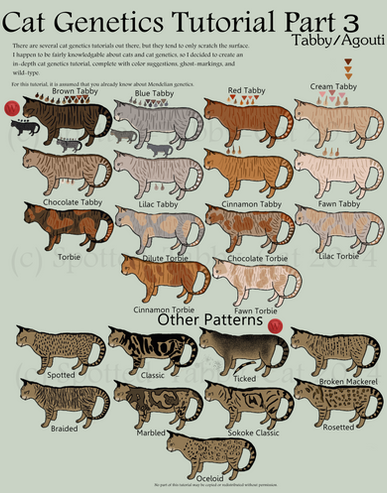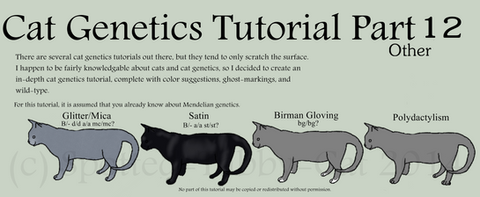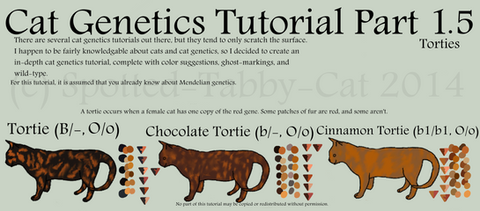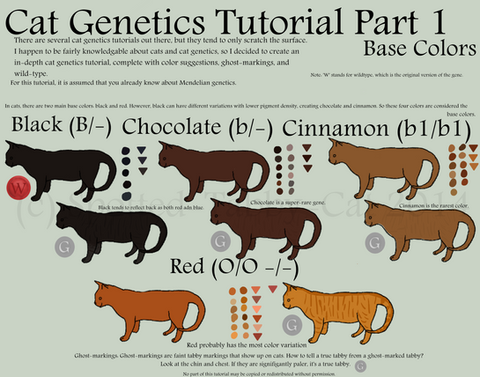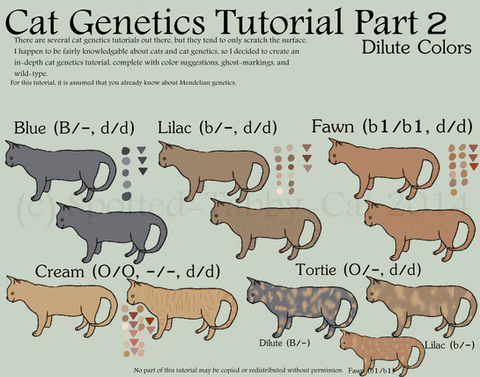HOME | DD
 Spotted-Tabby-Cat — Cat Genetics Tutorial Part 11 (Ears)
Spotted-Tabby-Cat — Cat Genetics Tutorial Part 11 (Ears)

Published: 2016-07-01 14:37:13 +0000 UTC; Views: 12332; Favourites: 123; Downloads: 98
Redirect to original
Description
This tutorial is out of date. Please see more information here .
There are multiple cat genetics tutorials about, but they tend to only cover the basics (base colors, dilutions, tabby, white-spotting, pointism, & tortie/orange). In-depth cat genetics tutorials tend to be lacking. So thus, this. I have no idea how long this will take to be completed. Hopefully before 2016 2017.
The classic cat ear is the round triangle shape, pricked up and listening to everything around. The folded ear gene is most commonly found in Scottish Folds. It is dominant, but lethal in homozygous form. Even in heterozygous form the gene can cause problems due to the weakened cartilage that makes the ear flop down. Two different degrees of folded ear are shown. Curled ears are associated with American Curls, and are dominant, but with no known side effects. Two different degrees of curled ear are shown. Both cats with folded and curled ears tend to be born with straight ears that transition to their final shape within several months. 'Four eared' cats have a double pinnae (the outer part of the ear that sticks up). It can appear in many different forms, and is often a one-off mutation. Weakened cartilage is often caused by external factors (mostly frostbite), and often shows up in wrinkled ears or a floppy tip.
Part 1 (Base Colors):
Cat Genetics Tutorial Part 1 (Base Colors)
Part 1.5 (Torties):
Cat Genetics Tutorial Part 1.5 (Torties)
Part 2 (Dilutions):
Cat Genetics Tutorial Part 2 (Dilutions)
Part 3 (Tabby):
Cat Genetics Tutorial Part 3 (Tabby/Agouti)
Part 4 (White-Spotting):
Cat Genetics Tutorial Part 4 (White)
Part 5 (Pointism & Albinism):
Cat Genetics Tutorial Part 5 (Pointism & Albinism)
Part 6 (Silver & Gold Series):
Cat Genetics Tutorial Part 6 (Silver & Gold Series)
Part 7 (Color Changes):
Cat Genetics Tutorial Part 7 (Color Changes)
Part 8 (Weirdos):
Cat Genetics Tutorial Part 8 (Weirdos)
Part 9 (Hair):
Cat Genetics Tutorial Part 9 (Hair)
Part 10 (Tail):
Cat Genetics Tutorial Part 10 (Tail)
Part 11 (Ears):
Cat Genetics Tutorial Part 11 (Ears)
Part 12 (Other):
Cat Genetics Tutorial Part 12 (Other)
Related content
Comments: 10

👍: 0 ⏩: 0

👍: 0 ⏩: 0

It's here! fav.me/darayjd
👍: 0 ⏩: 0

Thank you for this tutorial. I look forward to Part 12.
👍: 0 ⏩: 1

You're very welcome! Part 12 might be a while in coming due to life just being quite busy for me right now, but hopefully it will be up in the next couple of months.
👍: 0 ⏩: 0

I really love your cat genetics tutorials!
I wonder what your Part 12 and subsequent parts will look like?
I might like to see the recessive gloving gene (G) that is found in Birmans on one of them.
👍: 0 ⏩: 1

Thanks. I feel like I could have done a bit of a better job on parts, but they seem to be helping people understand cat genetics, which is what they were made for.
I'm pretty much going to be using Part 12 as an Anything-I-Forgot part and should be putting up a journal soon asking for any genes or mutations that I missed. I won't be including a lot of freak mutation stuff though.
I can certainly add Birman gloving to the list!
👍: 0 ⏩: 0


